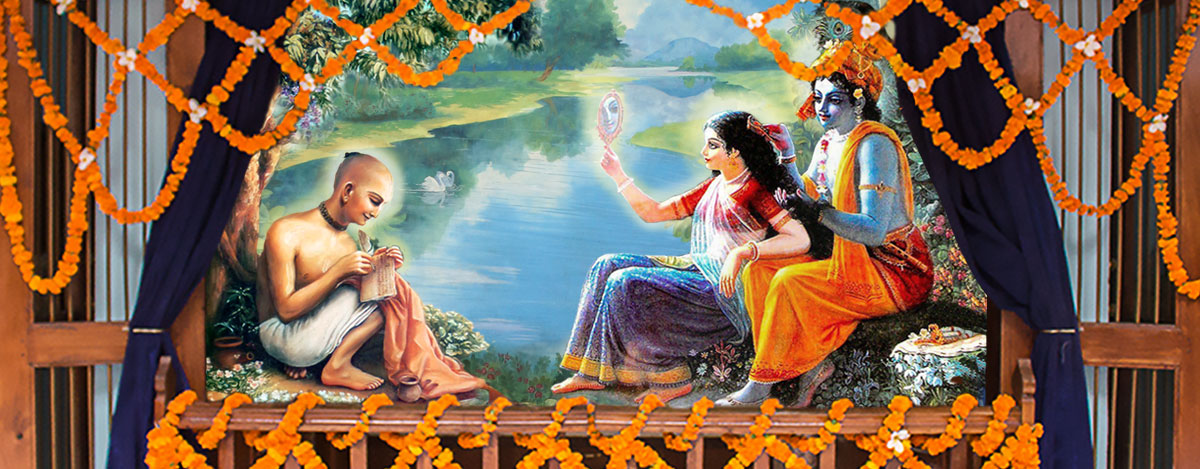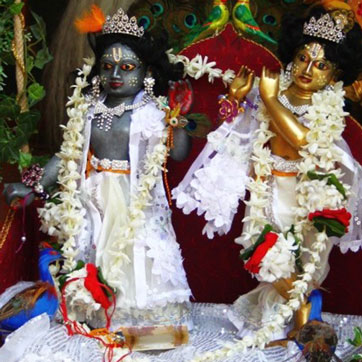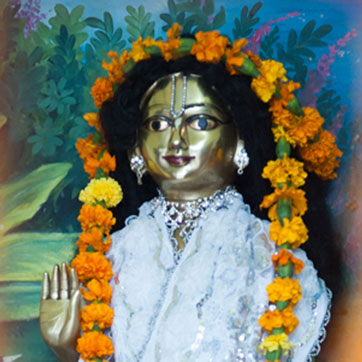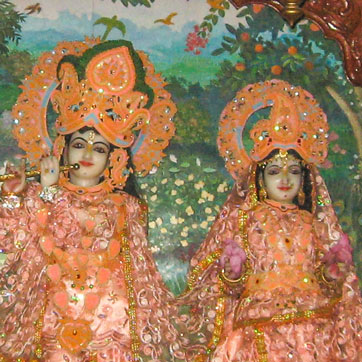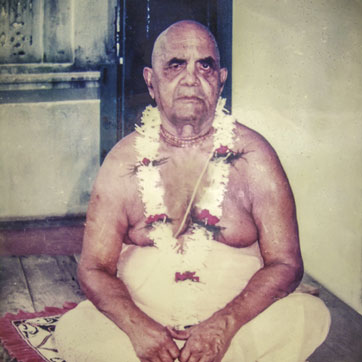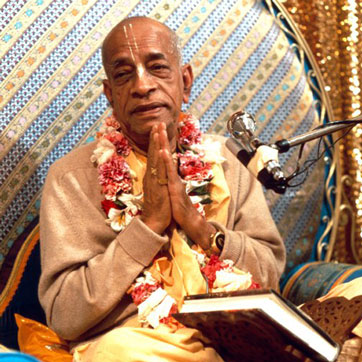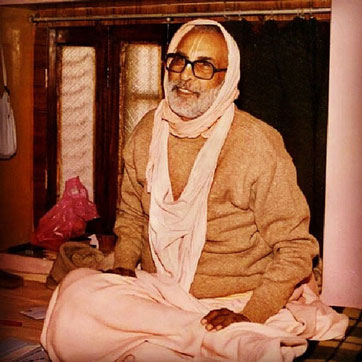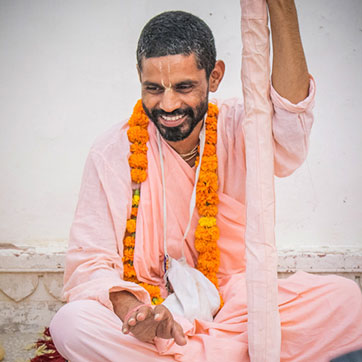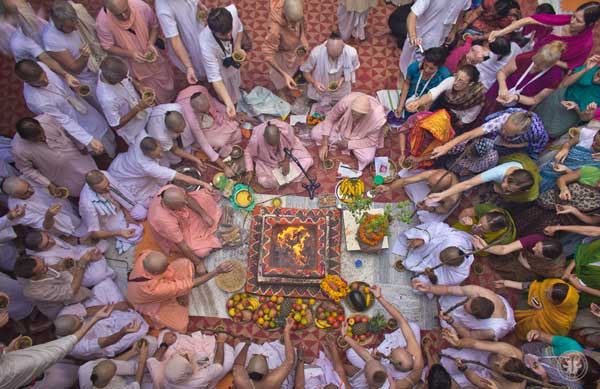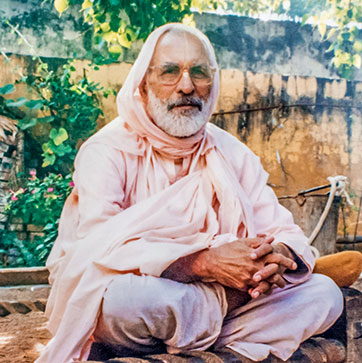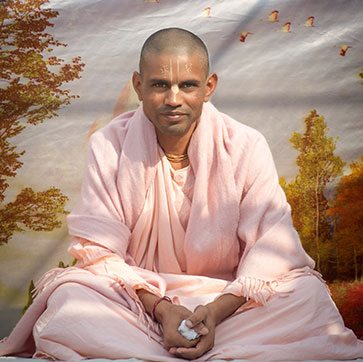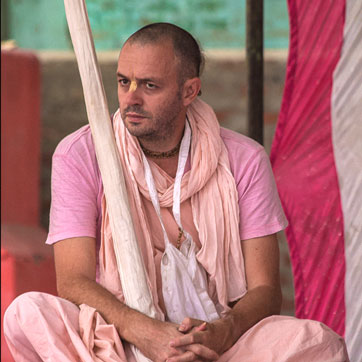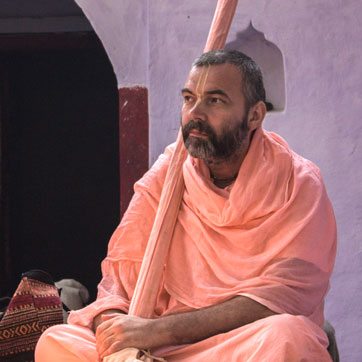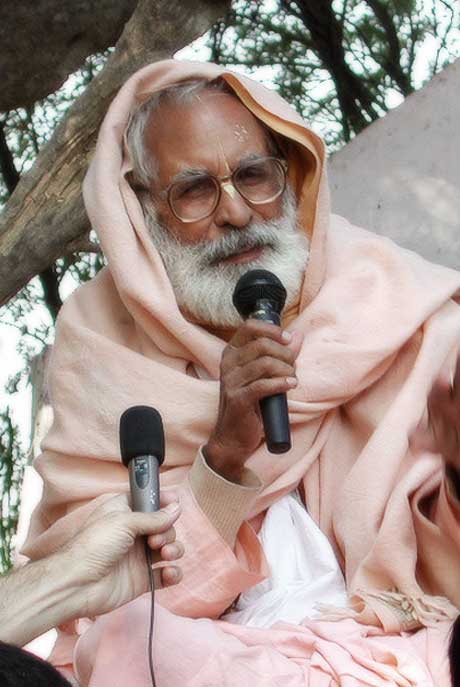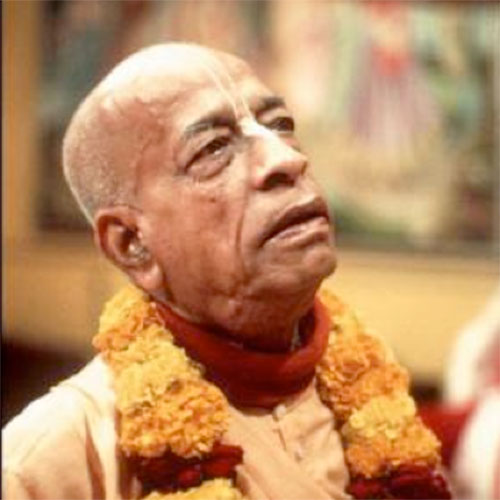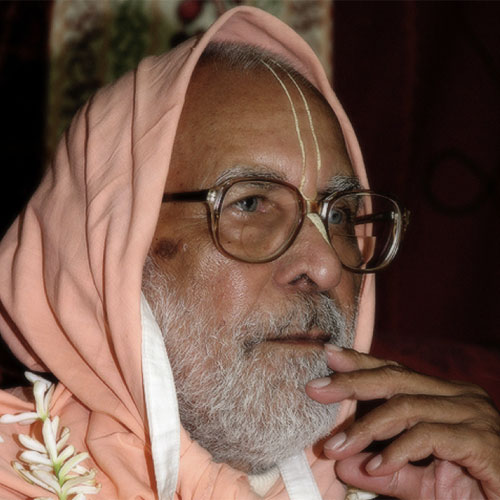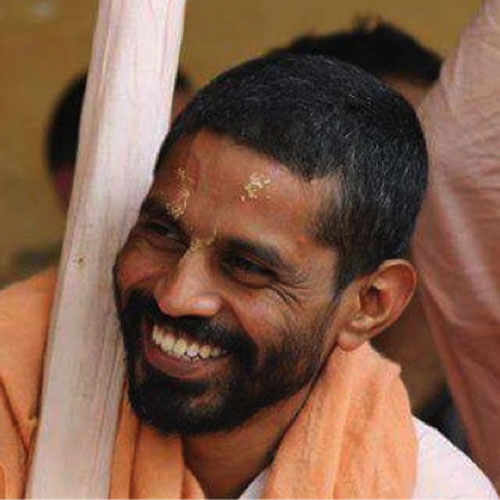The Vaisnava Calendar (Panjika) has been made in accordance with the rules for making exact solar and lunar calculations as delineated in Hari-bhakti-vilasa by Sri Sanatana Gosvami, and as followed by Sri Srimad Bhaktivedanta Narayana Gosvami Maharaja in the various locations he visited during his manifested worldwide preaching tours.
Calendar Day
A Vaisnava calendar day starts at sunrise and ends at the next sunrise (a civil calendar day is midnight to midnight.)
Timings
- All times listed are in 24-hour format HH:MM
- Times with asterisk in front, (e.g. *01:42) mean time is after midnight and before sunrise of next day.
- Times listed as --:-- indicate there is no ending time for tithi, nakshatra, or yoga on that day (from sunrise to next sunrise).
Columns
- Date: is expressed as day of month, month, year, and week day.
- Tithi/Ending: is tithi at sunrise time with tithi ending time. An * before ending time means after midnight and before next sunrise.
- Paksa: is either K or G for the dark or bright half of the lunar month. From Pratipat after Purnima until end of Amavasya is dark half designated by a K for Krishna because he has dark complexion, From Pratipat after Amavasya until end of Purnima is bright half of lunar month designated by G for Gaura, as he has fair complexion.
- Sunrise/Sunset: For sunrise time, we are using when the tip of the sun is truly on the eastern horizon.
- Nakshatra/Ending: There are 27 nakshatras or constellations. The nakshatra listed is the lunar constellation and time listed is when moon moves into the following constellation. Each nakshatra is 13°20" in the zodiac of 360°
Break Fast Times
The parana, or exact times within which to break a fast, is listed according to location. You will note that these times vary considerably. This is due to a location's specific sunrise/sunset time, and tithi ending time which is same instance all around the world.
Such times are marked by the words: Break fast times. For example, Amsterdam (06:53-10:51) informs a person in Amsterdam to break fast between 6.53am and 10.51am
Janmastami Break Fast Times: When Sri Kṛṣṇa's birth constellation Rohinī is in effect at sunrise on the break fast day, additional times are given for breaking fast.
- Janmastami Example: +Break fast 06:05 - 10:16, Better after 12:22*, Best after 15:03* (Daylight-saving time not considered)
In the above example, a mid-day break fast time is given (after 12:22) and also the time of the end of Rohinī constellation (15:03). If Rohinï constellation ends after sunset then only an additional mid-day time is given. If Rohinī constellation is not preset at all, or if Rohinī ends before mid-day, then only one break fast time is given.
Daylight Saving Time or Summer Time
Daylight-saving time (DST) is not considered in calendar calculations. This means that the exact break fast and eclipse times given herein do not take Daylight-saving time or "summer time" into account. The reader is therefore advised to add the DST difference for the local time zone (usually one hour ) when DST is in effect (during summer months). For example, 09:01 am becomes 10:01 am. When DST is not in effect, simply observe the local break fast or eclipse times as listed.
It is the desire of Sri Srimad Bhaktivedanta Narayana Gosvami Maharaja that the calculations for the individual time zones around the world be followed.
Calculations
We are using Bisuddha-siddhanta, also called Drik-siddhanta or modern observational astronomy for calculation of the positions of sun and moon. For sunrise calculation, we use the edge of the sun disc.
A tithi is the distance between the sun and moon against the background of the zodiac. As viewed from the earth, each tithi is 12° in distance between the sun and the moon. In the 360° of the zodiac, there are 30 tithis (360 /12=30). A synodic lunar month is about 29.53 days. Depending on speed of moon, sometimes a tithi is less than 24 hours and sometimes a tithi is greater than 24 hours. A tithi can begin or end any time of day or night.
Difference in printed calendar: Please check the web version before major events in case any changes have been made after printing.
Calendars used in Vrindavan and Mathura Maths: The Vrindavan and Mathura Maths follow use slightly different calculations for the calendar. You may find these calculations on the Vrindavan Calendar page.
Maha-dvadasi
There are eight special conditions when a dvadasi lunar tithi becomes a Maha-dvadasi. In such cases, fasting is done on the Maha-dvadasi and not the ekadasi. A Maha-dvadasi may be in effect for one location and not another. A regular dvadasi can also become a fast day for an ekadasi under certain conditions. Please pay attention to the fasting instructions for each location which are listed under the location name.
Special Festival Days
The Gaudiya Vaisnavas observe the appearance days of Visnu tattva incarnations of Lord Sri Krsna by fasting on those days (no grains): Sri Advaita Acarya, Lord Sri Nityananda Prabhu, Sri Caitanya Mahaprabhu, Lord Sri Ramacandra, Lord Sri Nrsimhadeva, Lord Sri Balarama, Lord Sri Krsna. For the festival days of Lord Varahadeva and Lord Vamanadeva which are on a dvadasi tithi, fasting is done on the dvadasi when it becomes a maha-dvadasi, else fasting is done the day before on ekadasi.
For more details and explanations about the different festivals and appearance and disappearance days, information about the various programs and festivities and related lectures, please visit www.purebhakti.com
Rules for Observing Ekadasi Fast and Break Fast
If you have observed a complete fast (meaning, you have not even taken water on Ekadasi day) you do not need to break the fast the following day with grains. You can break it with caranamrita (Krsna's foot bathing water) or fruit at the times mentioned herein. But if on Ekadasi you took fruit, vegetables, etc. then you should break it with grains next morning at the proper times listed for paran.
Maha-dvadasi is observed like Ekadasi when listed for your location.
Ekadasi
The essence of Ekadasi is to spend as much time as possible hearing, chanting and remembering Sri Sri Radha-Krsna. Therefore, on that day, it is recommended that one eat simply, only once or twice. Never eat meat, fish, eggs, onions, garlic, carrots, red lentils (masur dahl) green flat lentils, mushrooms or products thereof.
Restricted foods on Ekadasi:
-
Tomatoes, eggplants, cauliflower, broccoli, bell peppers, beets, bitter melon (karela), loki, parmal, toroi, kunli, drumsticks, bindi (ladies' fingers) and banana flowers, radish, squash, olives.
-
Peas, chickpeas and all types of beans, including products made from beans (e.g., papadams, tofu, tempeh and other soy products)
-
All leafy vegetables (e.g., spinach, salads, cabbages) and leafy herbs like parsley, coriander leaves, celery, curry leaves etc.
-
Grains (e.g., millet, barley, farina, pasta, rice, corn & quinoa) and all types of flour made from grains and beans (e.g., rice flour, chickpea flour, urad dahl flour) Buckweat is allowed on ekadasi
-
Starches from corn or grains, and products made from or mixed with these starches like baking soda, baking powder, certain soft drinks with corn syrup, custard, certain yoghurts and puddings, certain varieties of cream and cottage cheese, certain sweets and candies, and tapioca balls which often mixed with rice powder.
-
Oils made from grains (e.g., corn oil, mustard oil, soybean oil, sesame oil and general vegetable oil) and products fried in these oils (e.g., fried nuts, potato chips and other fried snack foods)
-
Honey, and sweets made with starches
Spices used only on Ekadasi:
Only black peppercorn (grind personally) and pure salt (preferably rock salt) taken from a new and clean package.
All other spices are not used on Ekadasi: (for example: hing (asafotida), cumin, fenugreek, mustard, tamarind, fennel, cardamom, kalanji, nutmeg, ginger and turmeric (fresh or not).
Foods that can be taken all days of the year, including Ekadasi, Caturmasya and Purusottama-masya:
-
All fresh fruits, all nuts and all oils made from nuts if it is pure.
-
Potatoes, pumpkin, cucumber, lemon, avocado, coconut, buckwheat, all sugars
-
All pure milk products (except yoghurt during the 2nd month of Caturmasya and milk during the 3rd month)
For sannyasis, brahmacaris and vanaprasthas: shaving head and cutting nails is to be done on full moon days only.
Caturmasya-Vrata (4 monhts ) and Purusottma-Vrata (1 month)
Restricted foods during the entire four months of Caturmasya:
-
Eggplants, tomatoes (if possible), loki, parmal, urad dahl, honey
Particular foods that are restricted during each of the four months:
-
First month: No leafy vegetables, such as spinach, salads of all types, cabbages of all types, kale, leafy herbs like coriander, mint, parsley, curry and powdered leafy herbs and teas
-
Second month: No yoghurt (if one requires it for health, it can be mixed with some water)
-
Third month: No milk (if required, it can be mixed with a drop of lemon juice)
-
Fourth month: No Urad dahl, mustard seeds, mustard oil, sesame seeds and sesame oil.
-
Puruṣottama month: No Urad dahl, mustard seeds, mustard oil, sesame seeds and sesame oil. Puruṣottama Māsa always comes inside one of the other twelve Vaisnava months. If it occurs during a Caturmasya month, then items forbidden during that month should also be avoided during Puruṣottama Māsa.
Eclipses
Eclipses are considered inauspicious. To counteract inauspicious effects and to create auspiciousness, during an eclipse one avoids sleeping, eating, drinking, bathing or using the bathroom. It is recommended to stay indoors, not to look at the eclipse, and constantly chant Harinama.
Eclipses listed for your location are global eclipses for the whole world with timings adjusted to your timezone without consideration of day or night, daylight savings or summer time. To determine if an eclipse listed should be followed for your location, see the below checklist:
1) Prenumbral lunar eclipses are not followed by Gaudiya Vaisnavas and are listed for your information only.
2) Partial and total solar eclipses that begin and end completly after sunset and before sunrise are not visible and thus they are not followed.
3) Partial and total lunar eclipses that begin and end completely afer sunrise and before sunset are not visible thus they are not followed.
4) Solar Eclipses - For all other partial and total solar eclipses, please see the related eclipse map. At this link, eclipse.gsfc.nasa.gov , look for sub section "Decade Solar Eclipse Tables" under the heading "Eclipses of the Sun". Select the correct decade. On next page that loads, scroll down to the eclipse table. In left hand column find date of the related eclipse and click on the date. A new window will open with the map of the eclipse. If your location is within the eclipse path, then please follow Vaisnava rules related to eclipses according to the eclipse time posted on the Vaisnava Calendar.
5) Lunar Eclipses - For all other partial and total lunar eclipses, please see the related eclipse map. At this link, eclipse.gsfc.nasa.gov , look for sub section "Decade Lunar Eclipse Tables" under the heading "Eclipses of the Moon". Select the correct decade. On next page that loads, scroll down to the eclipse table. In left hand column find date of the related eclipse and click on the date. A new window will open with the map of the eclipse. If your location is within the eclipse path, then please follow vaisnava rules related to eclipses according to the eclipse time posted on the Vaisnava Calendar.
If an eclipse is not visible in your location, it is not necessary to observe the rules. However, it is still considered an inauspicious time. Although you may find eclipse viewing instructions on the Nasa website, Gaudiya Vaisnavas do not recommend viewing eclipses.

